Simplified overview (- with colorful maps!)
I wanted to add this piece so as to make some of this clearer, but I'm undecided as to where to put it … someone glancing at the list of articles below this might wonder, the Vikings? Huns? Franks? WTF is this all about? … My 'Why Uroko' article eleborates somewhat, but falls short of explaining why I became interested in the roots of these peoples and what I (and others) call "dragon-culture". Putting this piece here, before the articles below, might give the reader some perspective and make it all easier to follow.
But reading this first comes at the risk of hearing the punchline before the joke. Think of a box of jigsaw puzzle pieces strewn out on a table which, as they get put together reveal a picture. The process of seeing the picture emerge gradually has been, for me, incredibly interesting. So, while this topic is deadly serious, if you don't want to ruin the fun of discovery, skip this article, come back to it later.
I'm no scholar, I'm no historian. But I've always been pretty good at solving puzzles, seeing patterns. I think it has something to do with how my brain is (mis-) wired. After a number of years of reading from a variety of sources (historical, conspiratorial, biblical, mythical etc.) and chasing down hunches, I think I have a general handle on how the so-called "dragon bloodline" has manifested in the real world.
Below I will attempt to plot, in a very general and simplistic fashion, the meandering of the main branches of this so-called dragon, however I don't contend that there is a literal blood connection between the ancient Sumerians and Egyptian Pharaohs to the present … I doubt that there is (… though there might, and some might believe it to be so). I simply see that there is a cultural connection apparent and that the movement of the concept of rule by divine right and the traditions of conquering culture can be traced.
The arrows below don't represent the movements of people so much as the movements of leadership and ideas associated with "dragon culture".
Without further ado,
It started amid a quartet of locales, between which advanced heirarchical society apparently evolved over many centuries (circa, 5 thousand years ago?) … primarily Egypt, Canaan, Sumer and Crete.
[EDIT: Scythia was probably an important 5th player in this, and there was also apparently a lot of early activity east of Ugarit in what would become 'Assyria', and I should make it clear that I am aware of these details but I don't want to confuse the issue more than necessary, i.e. this is the simplistic version – I'm trying to condense the important points so as to paint an otherwise difficult to access picture.]
Among these various early centers of budding civilization the Sumerians were probably ahead of the game, and that's probably why Sumer is usually accredited with being the fount from which "civilization" sprang. (To say nothing of the hypothesis that the biblical 'Eden' was located at the confluence of the Tigris and Euphrates rivers). … But there was so much cross-pollination between the three (or more) areas I'm talking about that I view them all as almost as a single root of origin. Archeological finds point to Sun worship, Dragon worship and Great-Mother worship being ubiquitous and much older than the apex of Sumerian civilization, but there are no written records preceding the Sumerian cuneiform texts (excepting the controversial Tartarian tablets of Romania) so I try not to speculate. Suffice to say that it apparently all came together in a meaningful way in Sumer, Canaan and Egypt and spread from there, and that the identifiers of the original 48 constellations with Draco the dragon at their center have been pegged scientifically as Mesopotamian. The orange-ish area coloured below is what is referred to as the "fertile crescent".
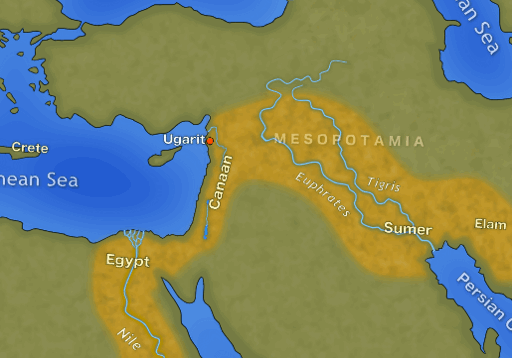
As these civilizations evolved, traded and competed, Sumerian ideas also travelled east, to the Indus Valley and eventually to China. Early trade between Sumer and the Indus Valley is confirmed in seals and other archeological finds. Pyramids (or 'Ziggurats, i.e. "step pyramids") were built all over this area, from Egypt to China.
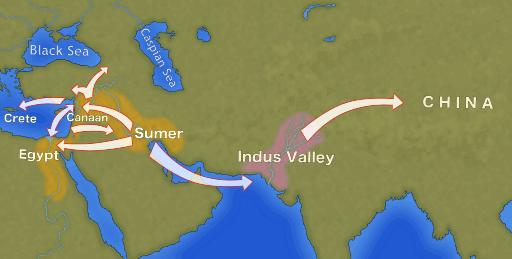
Gradually power shifted from ancient Sumer to the northwest as the Akkadian Empire dominated Mesopotamia. Hurrian and Elamite kingdoms became powerful, as did did the nomadic (and warlike) Amorites. Byblos, Sidon and Tyre became important Phoenician cities.
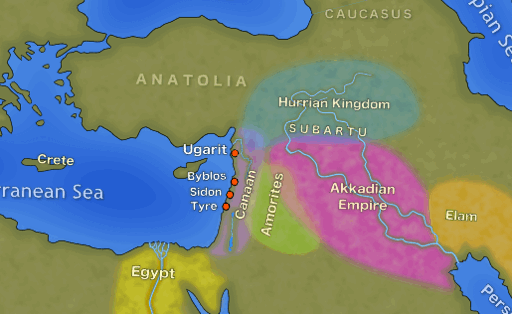
During the era concurrent with the biblical old-testament, inter-relations between Egypt and Canaan were extensive and complex. Canaan was often under Egyptian control, while during the reign of the Hyksos northern Egypt was ruled by "foreign kings", probably a Canaanite people. Stephen Franklin and others suggest that Abraham was one of many biblical patriarchs who were kings of Ugarit, and Abraham, Jacob, Joseph and Moses all spent time in Egypt as per biblical stories. Greek myths and accounts of Danaus arriving in Greece from Egypt may correllate with Dardanus, patriarch of the Trojan kings and namesake of the Dardanelles (straights between Anatolia and Thrace) who also is said to have arrived from Egypt (via Crete, depending on the myth), and this Dardanus may correllate with Darda, a son of Zerah and grandson of Judah. Judah in turn looks like the namesake of two mountains, one in Crete and one in western Anatolia, both of which were centers of Great Mother goddess worship, Mt. Ida in Crete being sacred to Rhea mother of Zeus, and Mt. Ida in Anatolia being sacred to Kybele. Taken together and along with an account by Josephus regarding correspondence between Sparta and Judea, the implication is that some early founders of parts of Greece and Troad (including the Trojan kings) and the patriarchs of the tribes of Israel were blood-related.
This migration out of Egypt would have preceded the Trojan War (date uncertain) and, assumedly, have corresponded with the biblical Exodus. Bolstering this view, Greek historian Hecateus was quoted by Diodorus Siculus as stating:
"The most distinguished of the expelled foreigners followed Danaus and Cadmus from Egypt; but the greater number were led by Moses into Judæa.”
Wow.
The numerous tribes collectively called 'Trojans' , led by the ancestors of Dardanus and who settled in Anatolia and Thrace in the area around the city of Troy (known as Troad) were so belligerent the Greeks had a saying – "drunk as a Thracian". Troad was Great Mother worship country, and it was here that the cults of Kybele and Sabazios were popular. These cults were very secretive and conducted perverted rituals that probably included drunken orgies, self-emasculation, child-sacrifice and who knows what else. Many of the important branches of the "dragon" passed through this location and time.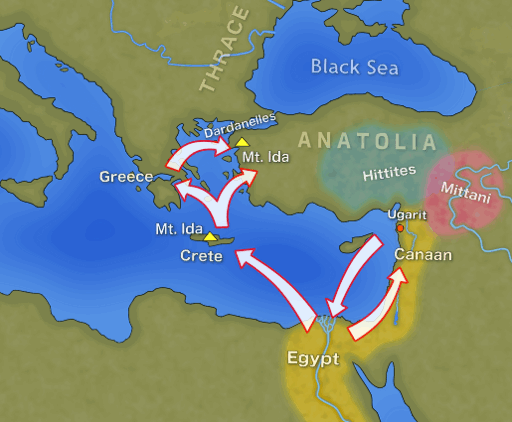
Following the fall of Troy, Trojan tribes fled to the opposite side of the Black Sea. Among them were the proto-Viking Aesir and Vanir, as well as the ancestors (i.e. the Cimmerians et al) of other tribes which would later emerge in Germania as the Franks.
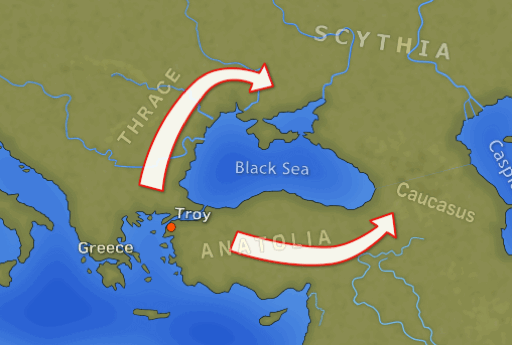
Meanwhile, another migration that apparently originated out of Canaan and/or northwestern Mesopotamia (I for one am pretty convinced, the clues are enumerated in my 'Huns' piece) accounted for the nomadic Turkic tribes which appeared in Mongolia circa 1200 B.C. (re: Chinese accounts). It is possible, given the time line, that these Turkic tribes (as they are known) fanned out from Troad like the proto-Vikings, Saxons, Goths and Franks, but this isn't indicated in any myths or records that I know of. They may have simply taken a separate route out of Canaan/Mesopotamia. Their nomadic nature suggests that they may have been Amorites, while the Magyars have been tentatively traced to the Mittani.
(Personally, I see a possible link between Magyar (from Magor) and 'Magan'. Also, the capital of the Hyksos in Egypt was Avaris, evoking the Avars. This too is just speculation, but I wonder if the nomadic tribes didn't branch off from the Hyksos after their expulsion from Egypt, while the proto-Trojans and Israelites branched off from a later expulsion, maybe connected with the backlash in Egypt following the reign of the monotheistic Akhenaton, who looks like he was Joseph/Yuya's son in law !?)
In China these nomadic tribes were known as the Xiongnu and while the relationship between the Chinese and Xiongnu was adversarial, on occasion Xiognu kings took Chinese princesses as wives. This accounts for the Liu name which was abundant among Han emperors being found also among Xiongnu royalty. Liu meant 'dragon'. If you don't believe me, 'dragon' in Japanese is 'Ryu' (with 'L' and 'R' being interchangeable).
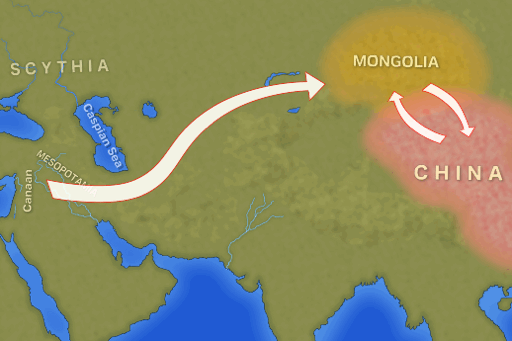
These tribes left Mongolia in great numbers following military defeats in early A.D. centuries, most migrating westward toward Central Asia and Europe where they would be known as Huns, Magyars, Khazars, Avars, Bulgars and other tribes, obstensibly all part of a "Hunnic federation". There is much confusion about these peoples, for they left no written records of their own. There is some (pretty good) evidence that other "Mongolians" fled east, to the Korean penninsula and to Japan. If true, those that arrived in Japan arrived just in time to unite the politically fragmented tribes there and begin ruling as "daimyo" (clan leaders) led by an Emperor "descended from Heaven".
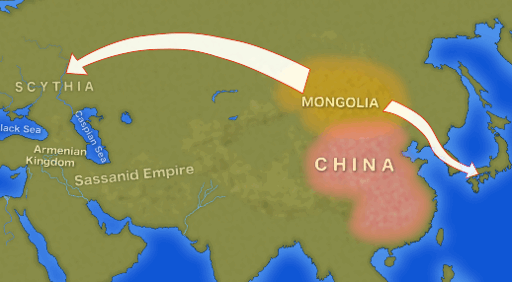
As the westward-fleeing Hunnic tribes (former Xiongnu) arrived in central Asia, proto-Viking and proto-Frank Germanic tribes left the Black Sea area and headed toward northern Europe. These events might be related somehow (i.e. the arriving Huns pushed them out), and there is a theory that Uldin of the Bulgars and Woden (or Odin) of the Vikings were one and the same person. Meanwhile Hunnic tribes pressed into Europe in the 4th and 5th centuries A.D. and threatened the Roman Empire, notably under Attila. They were pushed back.
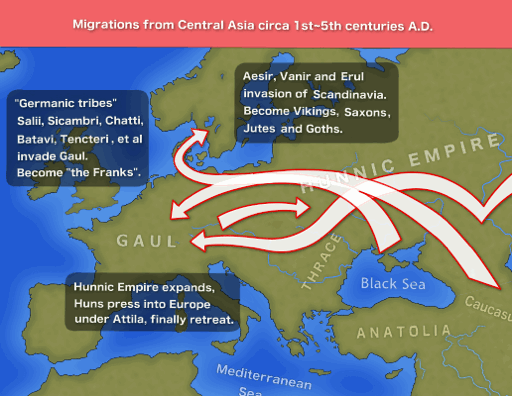
Beginning around the 6th century, as all of Gaul was coming under control of the Merovingian Franks, Vikings of the Saxon, Angle and Jute persuasions gradually conquered England. The Celts, who were there first (and who were probably a "dragon" branch of earlier migrations) were assimilated or retreated to Wales and other areas where Gaelic culture survived.
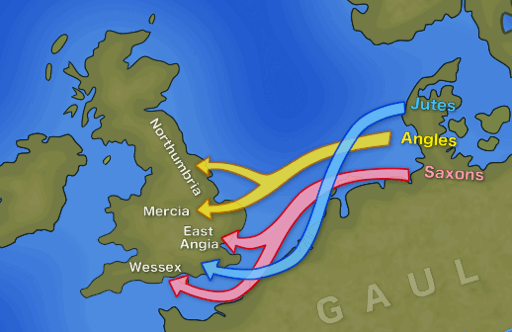
By around the 8th century, Europe and Central Asia looked something like this … the Avars, another nomadic "Turkic" group which had arrived in Central Asia from Mongolia had built a great empire which Charlemagne and his son Pippin would conquer at the end of the century. Following their subjugation many western Avars were transplanted to France. At around the same time the great empire of Khazaria, led by the Khazars and which had risen out of the large Hunnic federation in the area, converted officially to Judaism. (The extent of this conversion is contentious, it may have pertained primarily to the aristocracy and ruling Kagans.)
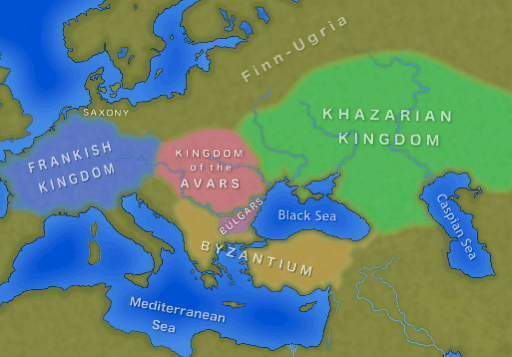
Finally in the late 9th century Rollo the Viking invaded northern France while Magyar and Kabar tribes led by the Arpad descendents of Attila the Hun invaded and settled in what become Hungary. Charles "the Simple" made peace with Rollo in 911 A.D. with the Treaty of Saint Clair-sur-Epte. Rollo and his Vikings were granted the lands of Normandy, and Rollo took a noble Frankish wife (Poppa of Valois). Meanwhile the Varangian Rus took control over most of the Russian lands between the Baltic and Black Seas. Soon Vladimir I's royal Varangian blood-line, the royal Hunnic Arpad line, Rollo's Viking Sinclair line, several noble Frank and Saxon lines and the Carolingian line of Charlemagne began to intermarry.
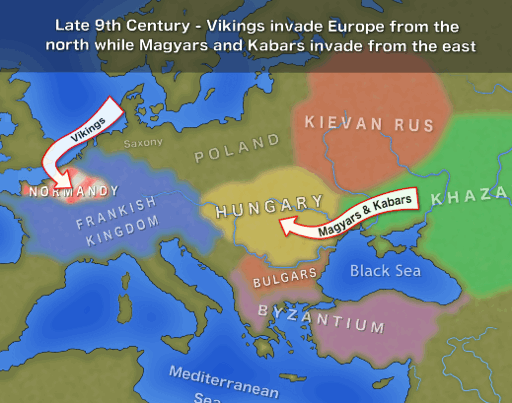
Because three of the families in charge of several of these "branches" were related to Melissena (see article), royal Khazar and Byzantine blood also flowed into the mix. Together with the branch that had become the Jewish people (which split off from Egypt before settling in Judea and Israel), these all constitute the "dragon bloodline". (This may be synonymous with what some call the "Rose Line", though I suspect that the Rose-Line, or "Rus-line", is more specific and pertains in some way to 'Red' … I will try to flesh that out at some point).
There are some holes, I admit, and maybe it turns out that I'm off a bit here or there … but the overall picture looks something like that, I'm pretty sure. The clues, which are numerous and which will come to light in other articles, all point to this sort of general overview.
EDIT:
I think I've cracked it … Red, "rus", "ros", "roos", i.e. the "Rose Line" just means RED. These Viking/Frank-descended families all descend from Zerah, twin of Pharez and son of Judah. Pharez' descendents are the Jews. Zerah's descendants are the "Red-Line" – the Germanic/Pagan-then-Christian branch of the "seed of Abraham". In the bible, the midwife tied a red thread around Zerah's wrist to mark him as the first-born.
In the 'DaVinci Code', the novel inspired by the material in 'Holy Blood-Holy Grail' the "Rose Line" is a 'lay-line' – something GEOGRAPHICAL.
But maybe it's something GENEALOGICAL, i.e. those descended from Zerah, the twin of Pharez, the twin born of Judah with the red string.
Original content may be quoted or replicated under the Fair Use doctrine. All other rights reserved.
My good criminy!
I just went to see what the flag of my ancestors is and ITS ALL DRAGON!
http://en.wikipedia.org/wiki/File:Flag_of_Wales_2.svg
Oh, yeah, the Welsh red dragon!
I really should dive into the whole topic of the Welsh branch of the "dragon", I think there's probably a wealth of interesting information there, related to the Arthurian legends, and a possible link between words like "Avar" and Avalon (the official etymology is that Avalon derives from 'aval' meaning 'apple', but that just piques my interest more given the richness of apple orchards and their connection to dragons and serpents in mythology). Morgan La Fey, as I note in 'Icons', is dressed traditionally in Green and Gold, the colors of the coat of arms of Morgan, that elite Welsh family of bankers and pirates. 😀
Anyway, thanx for commenting, (and sorry it took so long to add the above).
I love your article. I reposted it, gave you full attribution and linkback.
Ken
This is one awesome blog.Thanks Again. Much obliged.
Where are these maps from? Did you make them or are they from a textbook or documentary? I'm collectin resources for the history class I teach.
I made them myself. This is history as I have come to understand it, thus far, it's not the accepted view.